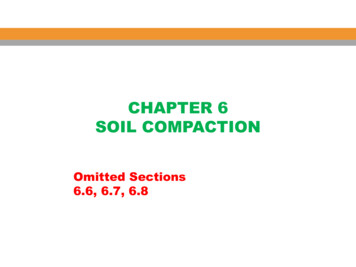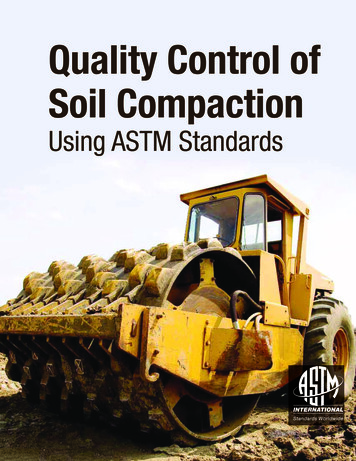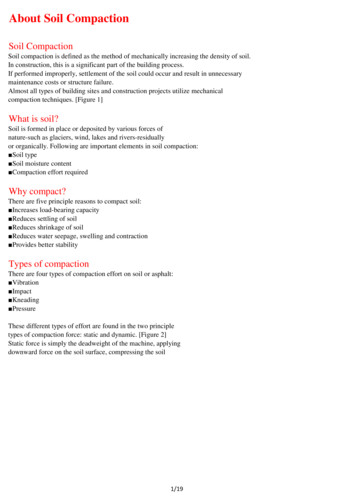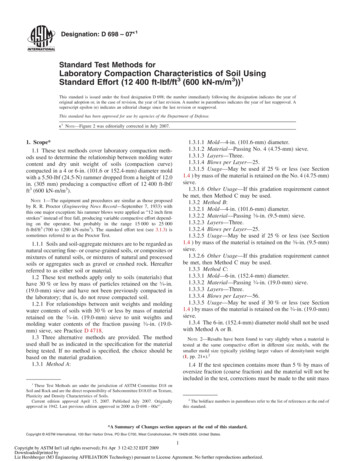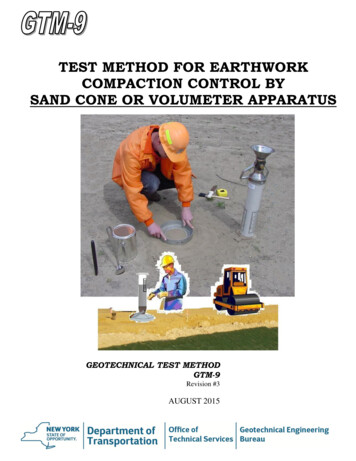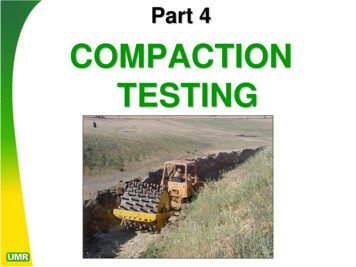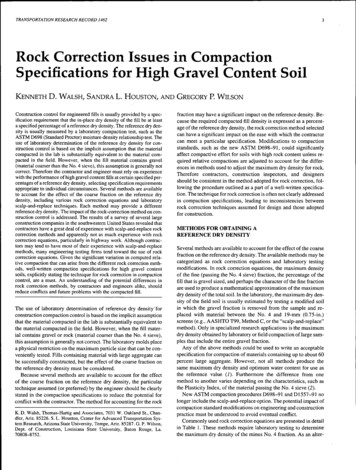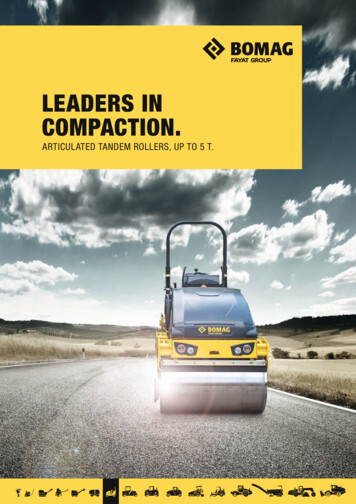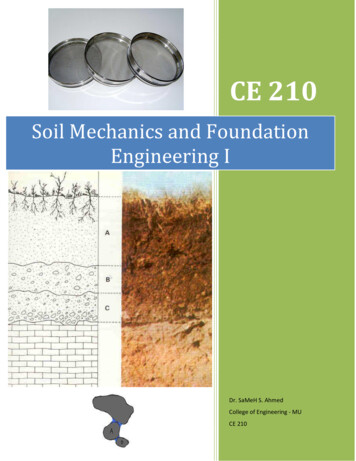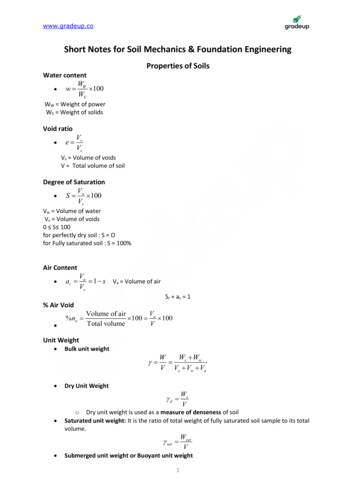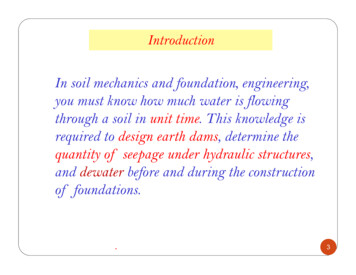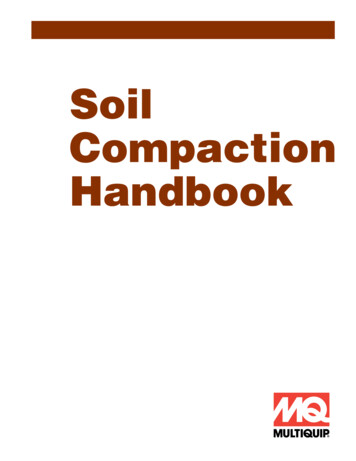
Transcription
SoilCompactionHandbook
Soil CompactionSoil compaction is defined as the method of mechanically increasing the density of soil. In construction,this is a significant part of the building process.If performed improperly,soil densitysettlement of the soil could occurand result in unnecessarymaintenance costs or structurefailure.Almost all types of building sitesand construction projects utilizeLoose Soil (poor load support)mechanical compactionFigure 1Compacted Soil (improved load support)techniques.What is soil?Soil is formed in place or deposited by various forces of nature—such as glaciers, wind, lakes and rivers—residually or organically.Following are important elements in soil compaction: Soil typeSoil moisture contentCompaction effort requiredWhy compact?There are five principle reasons to compact soil: Increases load-bearing capacityPrevents soil settlement and frost damageProvides stabilityReduces water seepage, swelling and contractionReduces settling of soilTypes of compactionThese different types of effort are found in the two principle types ofcompaction force: static and vibratory.Static force is simply the deadweight of the machine, applyingdownward force on the soil surface, compressing the soil particles.The only way to change the effective compaction force is byadding or subtracting the weight of the machine. Static compactionis confined to upper soil layers and is limited to any appreciabledepth. Kneading and pressure are two examples of staticcompaction.Vibratory force uses a mechanism, usually engine-driven, tocreate a downward force in addition to the machine’s static weight.The vibrating mechanism is usually a rotating eccentric weight orpiston/spring combination (in rammers). The compactors deliver arapid sequence of blows (impacts) to the surface, thereby affectingthe top layers as well as deeper layers. Vibration moves throughthe material, setting particles in motion and moving them closertogether for the highest density possible. Based on thematerials being compacted, a certain amount of force must beused to overcome the cohesive nature of particular particles.There are four types of compaction effort on soil or asphalt: VibrationImpactKneadingPressureSOIL COMPACTION HANDBOOK3
results of poor compactionFigure 2These illustrations show the results of improper compaction and how proper compaction can ensure a longer structural life,eliminating future foundation problems.Soil Types and ConditionsEvery soil type behaves differently with respect to maximumdensity and optimum moisture. Therefore, each soil type has itsown unique requirements and controls both in the field and fortesting purposes. Soil types are commonly classified by grain size,determined by passing the soil through a series of sieves to screenor separate the different grain sizes.[See Figure 3]A soil’s makeup determines the best compaction method to use.There are three basic soil groups: Cohesive Granular Organic (this soil is not suitable for compaction and will notbe discussed here)Soil classification is categorized into 15 groups, a system setup by AASHTO (American Association of State Highway andTransportation Officials). Soils found in nature are almost alwaysa combination of soil types. A well-graded soil consists of a widerange of particle sizes with the smaller particles filling voidsbetween larger particles. The result is a dense structure that lendsitself well to compaction.4SOIL COMPACTION HANDBOOK
sieve testCohesive soilsCohesive soils have the smallest particles. Clay has a particle sizerange of .00004" to .002". Silt ranges from .0002" to .003". Clay isused in embankment fills and retaining pond beds.CharacteristicsCohesive soils are dense and tightly bound together by molecularattraction. They are plastic when wet and can be molded, butbecome very hard when dry. Proper water content, evenlydistributed, is critical for proper compaction. Cohesive soils usuallyrequire a force such as impact or pressure. Silt has a noticeablylower cohesion than clay. However, silt is still heavily reliant onwater content. [See Figure 4]Granular soilsGranular soils range in particle size from .003" to .08" (sand) and.08" to 1.0" (fine to medium gravel). Granular soils are known fortheir water-draining properties.CharacteristicsSand and gravel obtain maximum density in either a fully dry orsaturated state. Testing curves are relatively flat so density can beobtained regardless of water content.The tables on the following pages give a basic indication of soilsused in particular construction applications. [See Figures 5, 6 & 7]Figure 3Figure 4guide to soil typesWhat to look forAppearance/feelWater movementWhen moist.When dry.Granular soils, finesands and silts.Coarse grains canbe seen. Feels grittywhen rubbed betweenfingers.When water and soilare shaken in palm ofhand, they mix. Whenshaking is stopped,they separate.Very little or noplasticity.Little or no cohesivestrength when dry.Soil sample willcrumble easily.Cohesive soils, mixesand clays.Grains cannot be seenby naked eye. Feelssmooth and greasywhen rubbed betweenfingers.When water and soilPlastic and sticky.are shaken in palm of Can be rolled.hand, they will not mix.SOIL COMPACTION HANDBOOKHas high strengthwhen dry. Crumbleswith difficulty. Slowsaturation in water.5
relative desirability of soils as compacted fillRelative Desirability for Various Uses(navfac dm-7.2, may 1982)(1 best; 14 least desirable)Canal SectionsFoundationsRoadwaysFrost HeaveNot PossibleFrost d gravels, gravel/sandmixtures, little or no fines----22----333--GMSilty gravels, poorly-gradedgravel/sand/silt mixtures24--4414495GCClay-like gravels, poorly gradedgravel/sand/clay mixtures11--3126551SWWell-graded sands, gravellysands, little or no fines----3*6----2224SPPoorly-graded sands, gravellysands, little or no fines----4*7*----564--SMSilty sands, poorly-graded sand/silt mixtures45--8*5**376106SCClay-like sands, poorly-gradedsand/clay mixtures32--5248762MLInorganic silts and very finesands, rock flour, silty or clay-likefine sands with slight plasticity66----6**691011--CLInorganic clays of low to mediumplasticity, gravelly clays, sandyclays, silty clays, lean clays53--93510977OLOrganic silts and organic silt-claysof low plasticity88----7**7111112--MNOrganic silts, micaceous ordiatomaceous fine sandy or siltysoils, elastic silts99------8121213--CHInorganic clays of high plasticity,fat clays77--108***913138--OHOrganic clays of medium highplasticity1010------10141414--ShellWell-graded gravels, gravel/sand mixtures, little or no finesSoil TypeCoreSeepageNot ImportantFillsSeepageImportantErosion ResistanceHomogeneousEmbankmentRolled Earth Fill DamsCompactedEarth LiningGRAVELSSANDSLEANCLAYS & SILTSif gravellyerosion criticalvolume change criticalnot appropriate for this type of useGWGroupSymbolFAT******--Figure 56SOIL COMPACTION HANDBOOK
materialsVibrating SheepsfootRammerLiftThicknessStatic SheepsfootGrid RollerScraperVibratingPlate CompactorVibrating RollerVibrating Sheepsfootpressureimpactvibrationwith kneadingScraperRubber-tired RollerLoaderGrid Rollerkneadingwith pressureGravel12 PoorNoGoodVery GoodSand10 /-PoorNoExcellentGoodSilt6 /-GoodGoodPoorExcellentClay6 /-ExcellentVery GoodNoGoodFigure 6Effect of moistureThe response of soil to moisture is very important, as the soilmust carry the load year-round. Rain, for example, may transformsoil into a plastic state or even into a liquid. In this state, soil hasvery little or no load-bearing ability.Moisture vs soil densityMoisture content of the soil is vital to proper compaction.Moisture acts as a lubricant within soil, sliding the particlestogether. Too little moisture means inadequate compaction—the particles cannot move past each other to achieve density.Too much moisture leaves water-filled voids and subsequentlyweakens the load-bearing ability. The highest density for mostsoils is at a certain water content for a given compaction effort.The drier the soil, the more resistant it is to compaction. In awater-saturated state the voids between particles are partiallyfilled with water, creating an apparent cohesion that binds themtogether. This cohesion increases as the particle size decreases(as in clay-type soils). [See Figure 8]fill radeVery HighExcellentExcellentNoVery EasyMediumGoodGoodNoEasySiltMedium LowPoorPoorSomeSomeClayNone ModerateLowVery PoorGravelSandorganicExpansivePoor DifficultNot AcceptableSomeCompactionDifficultyVery DifficultVery DifficultFigure 7SOIL COMPACTION HANDBOOK7
Soil density testsTo determine if proper soil compactionis achieved for any specific construction application, several methods weredeveloped. The most prominent by far issoil density.moisture vs soil densityWhy testSoil testing accomplishes the following: Measures density of soil forcomparing the degree of compactionvs specs Measures the effect ofmoisture on soil density vs specs Provides a moisture density curveidentifying optimum moistureFigure 8Types of testshand testA quick method of determining moisture density is knownas the “Hand Test.”Pick up a handful of soil. Squeeze it in your hand. Openyour hand.If the soil is powdery and will not retain the shape made byyour hand, it is too dry. If it shatters when dropped, it is toodry.If the soil is moldable and breaks into only a couple ofpieces when dropped, it has the right amount of moisturefor proper compaction.Tests to determine optimum moisture content are done in thelaboratory. The most common is the Proctor Test, or ModifiedProctor Test. A particular soil needs to have an ideal (or optimum)amount of moisture to achieve maximum density. This isimportant not only for durability, but will save money because lesscompaction effort is needed to achieve the desired results.Proctor Test (ASTM D1557-91)The Proctor, or Modified Proctor Test, determines the maximumdensity of a soil needed for a specific job site. The test firstdetermines the maximum density achievable for the materials anduses this figure as a reference. Secondly, it tests the effects ofmoisture on soil density. The soil reference value is expressed asa percentage of density. These values are determined before anycompaction takes place to develop the compaction specifications.Modified Proctor values are higher because they take into accounthigher densities needed for certain types of construction projects.Test methods are similar for both tests. [See Figure 10]Field testsIt is important to know and control the soil density duringcompaction. Following are common field tests to determine on thespot if compaction densities are being reached.If the soil is plastic in your hand, leaves small traces ofmoisture on your fingers and stays in one piece whendropped, it has too much moisture for compaction.Figure 98SOIL COMPACTION HANDBOOK
proctor testFigure 10field density testing methodsSand ConeBalloon DensometerShelby Tube Large sample Direct reading obtained Open graded material Fast Deep sample Under pipe haunches Many steps Large area required Slow Halt equipment Tempting to accept flukes Slow Balloon breakage Awkward Small sample No gravel Sample not alwaysretained No sample Radiation Moisture suspect Encourages amateursErrors Void under plate Sand bulking Sand compacted Soil pumping Surface not level Soil pumping Void under plate Overdrive Rocks in path Plastic soil Miscalibrated Rocks in path Surface prep required BackscatterCost Low Moderate Low HighAdvantagesDisadvantages Large sample AccurateNuclear Gauge Fast Easy to redo More tests(statistical reliability)Figure 11SOIL COMPACTION HANDBOOK9
sand cone testSand Cone Test (ASTM D1556-90)A small hole (6” x 6” deep) is dug in the compacted material to betested. The soil is removed and weighed, then dried and weighedagain to determine its moisture content. A soil’s moisture is figuredas a percentage. The specific volume of the hole is determined byfilling it with calibrated dry sand from a jar and cone device. Thedry weight of the soil removed is divided by the volume of sandneeded to fill the hole. This gives us the density of the compactedsoil in lbs per cubic foot. This density is compared to the maximumProctor density obtained earlier, which gives us the relative densityof the soil that was just compacted. [See Figure 12]Nuclear Density (ASTM D2922-91)Nuclear Density meters are a quick and fairly accurate wayof determining density and moisture content. The meter usesa radioactive isotope source (Cesium 137) at the soil surface(backscatter) or from a probe placed into the soil (directtransmission). The isotope source gives off photons (usuallyGamma rays) which radiate back to the meter’s detectors on thebottom of the unit. Dense soil absorbs more radiation than loosesoil and the readings reflect overall density. Water content (ASTMD3017) can also be read, all within a few minutes. A relativeProctor Density is obtained after comparing maximum density withthe compaction results from the test. [See Figure 13]Figure 12nuclear testFigure 13Soil Modulus (soil stiffness)This field-test method is a very recent development thatreplaces soil density testing. Soil stiffness is the ratio of force-todisplacement. Testing is done by a machine that sends vibrationsinto the soil and then measures the deflection of the soil from thevibrations.10This is a very fast, safe method of testing soil stiffness. Soilstiffness is the desired engineering property, not just dry densityand water content. This method is currently being researched andtested by the Federal Highway Administration.SOIL COMPACTION HANDBOOK
Compaction EquipmentApplicationsThe desired level of compaction is best achieved by matching thesoil type with its proper compaction method. Other factors mustbe considered as well, such as compaction specs and job siteconditions. Cohesive soils—clay i
Proctor Test (ASTM D1557-91) The Proctor, or Modified Proctor Test, determines the maximum density of a soil needed for a specific job site. The test first determines the maximum density achievable for the materials and uses this figure as a reference. Secondly, it tests the effects of moisture on soil density. The soil reference value is expressed as a percentage of density. These values are .
